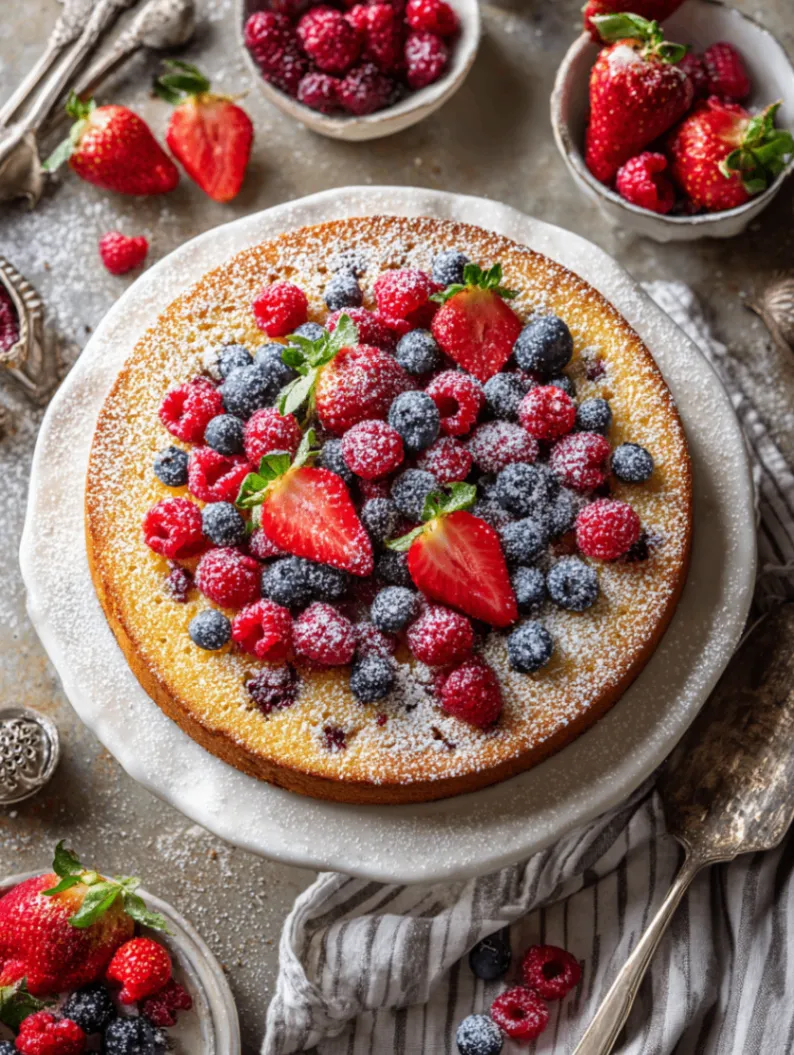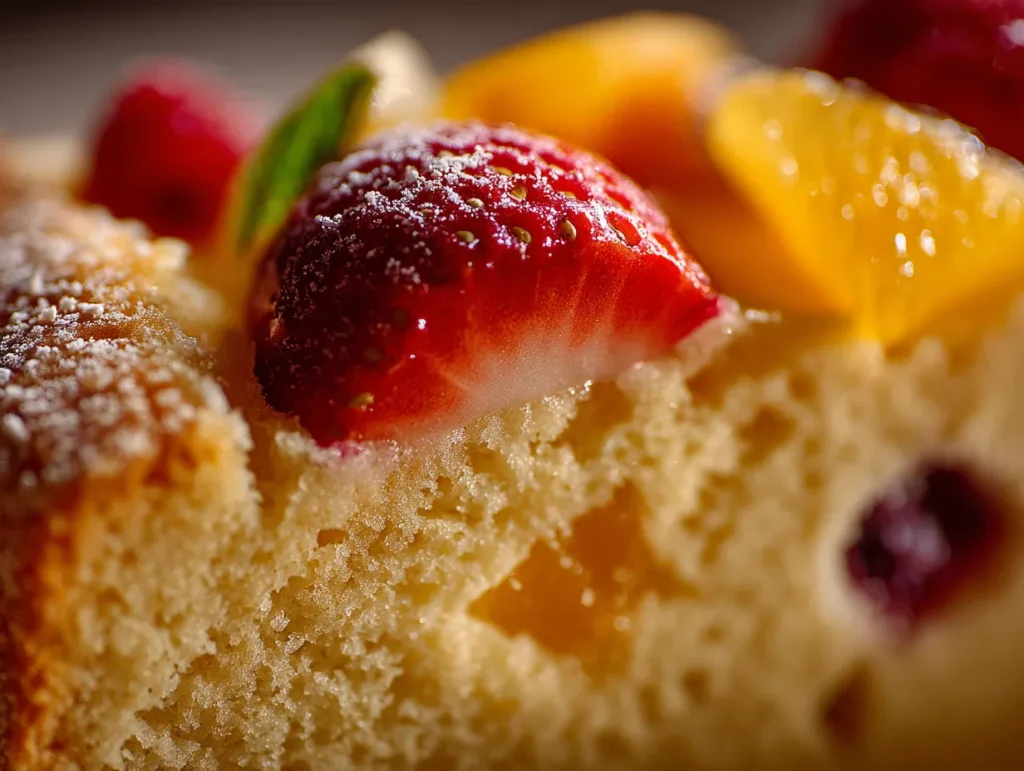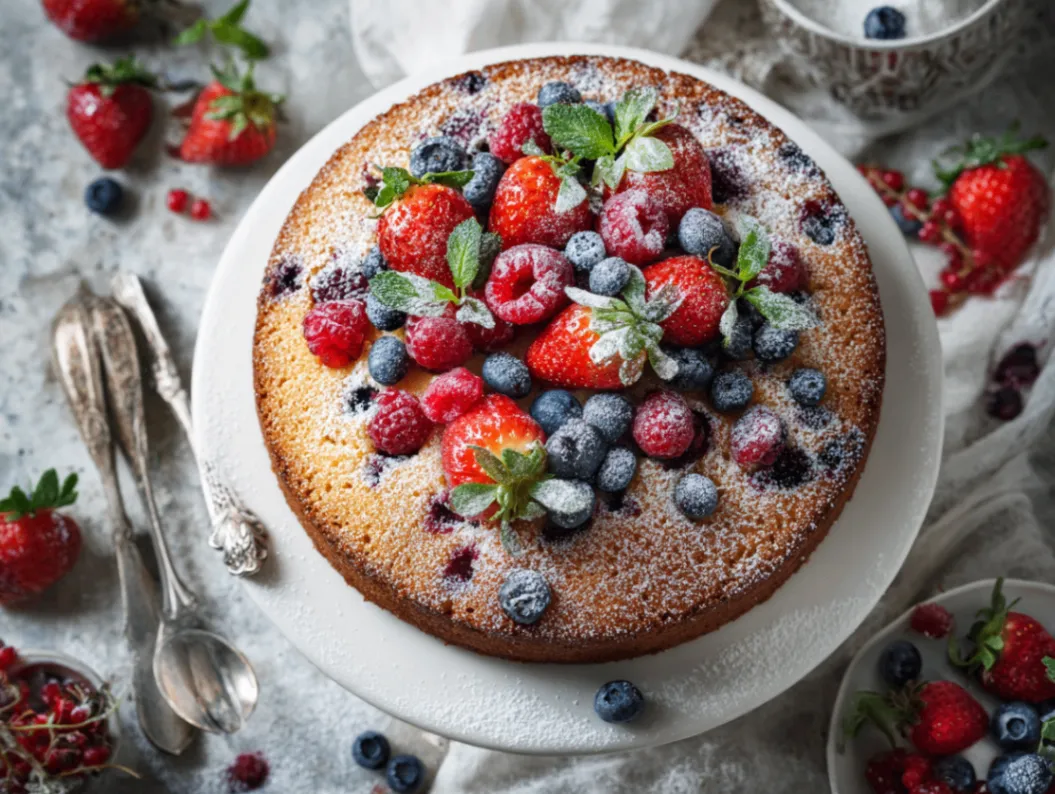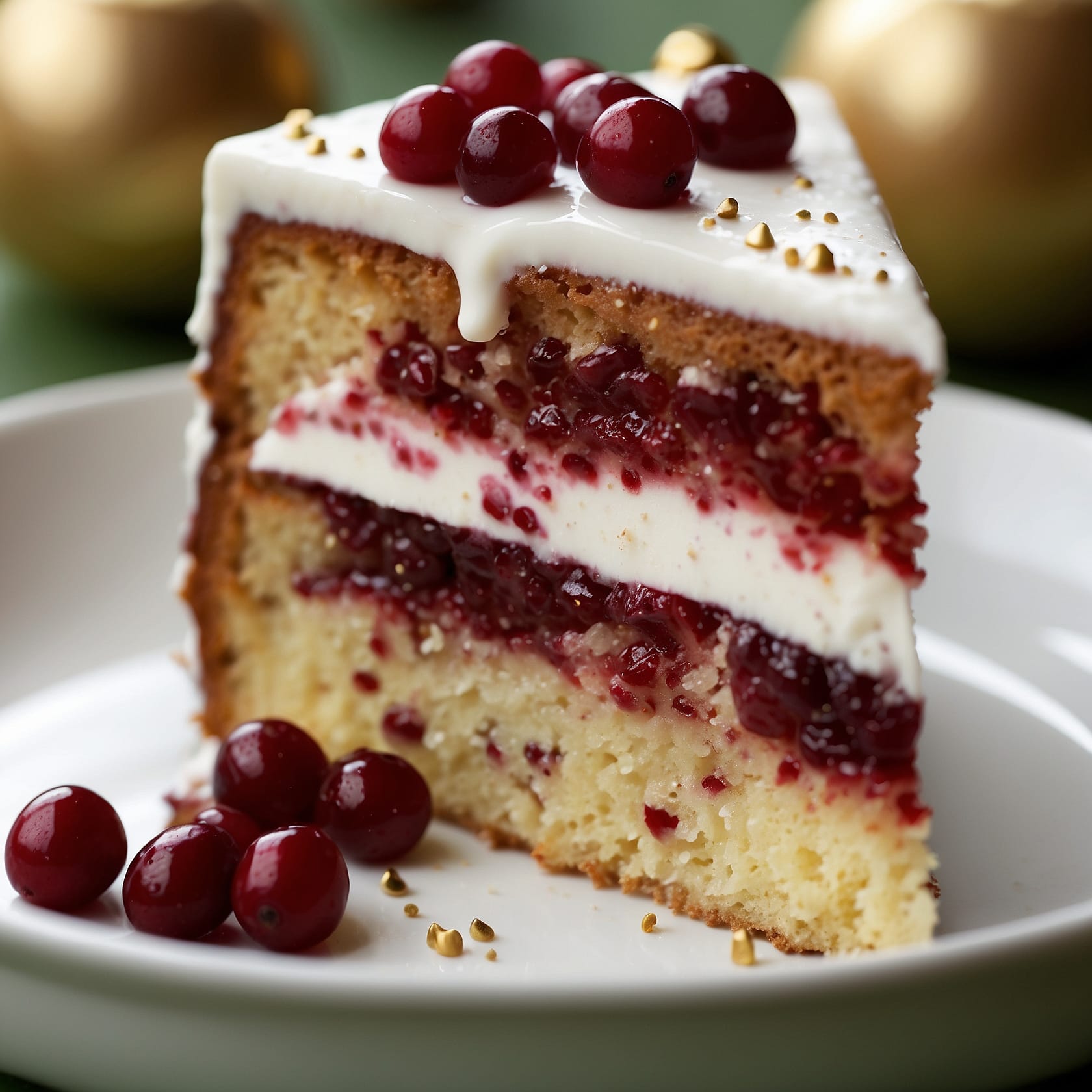Table of Contents
There’s something magical about a Fresh Fruit Sponge Cake that instantly transports me back to my grandmother’s kitchen on warm summer afternoons. The sweet aroma of vanilla and eggs dancing with the vibrant colors of seasonal fruits created memories that have shaped my entire culinary journey. This Fresh Fruit Sponge Cake isn’t just a dessert—it’s a canvas for nature’s sweetest artwork and one of my absolute favorite recipes to share with loved ones.
I’ll never forget the first time I attempted to recreate Nana’s legendary Fresh Fruit Sponge Cake for my daughter’s birthday party. The anticipation in the kitchen, the careful folding of ingredients, and that magical moment when the cake emerged from the oven, golden and perfectly risen—it was pure joy. Today, this Fresh Fruit Sponge Cake has become our family’s go-to celebration dessert, and I’m thrilled to share every secret and tip I’ve learned along the way.
This delightful cake represents everything I love about homemade baking: simplicity meets elegance, seasonal ingredients shine, and every bite tells a story. Whether you’re a seasoned baker or just starting your culinary adventure, this Fresh Fruit Sponge Cake will become a treasured addition to your recipe collection.

Fresh Fruit Sponge Cake
Ingredients
Tried this recipe?
Let us know how it was!Understanding Your Fresh Fruit Sponge Cake Ingredients
The Foundation: Key Ingredients and Their Magic
Creating the perfect Fresh Fruit Sponge Cake starts with understanding how each ingredient contributes to the final masterpiece. The beauty of this recipe lies in its simplicity—just a handful of quality ingredients working in perfect harmony.
The eggs are the true stars of any sponge cake, providing both structure and that coveted light, airy texture. I always use large, room-temperature eggs because they whip better and create more volume. The sugar isn’t just for sweetness; it stabilizes the egg foam and creates that tender crumb we all love. When making a Fresh Fruit Sponge Cake, I prefer superfine sugar as it dissolves more easily and creates a smoother batter.
Flour provides the structure, but it’s crucial not to overmix once it’s added. I’ve learned that cake flour creates the most delicate texture, though all-purpose flour works beautifully too. The butter, when properly incorporated, adds richness without weighing down the sponge. Fresh fruits are obviously the crown jewel—they should be at their peak ripeness for maximum flavor impact.
The vanilla extract might seem like a small addition, but it enhances all the other flavors and adds that homemade touch that makes this Fresh Fruit Sponge Cake so special. A pinch of salt might surprise you, but it actually enhances the sweetness and balances all the flavors perfectly.
Selecting Premium Ingredients for Maximum Impact
The secret to an exceptional Fresh Fruit Sponge Cake lies in choosing the finest ingredients available. I’ve learned that quality ingredients can transform a good cake into an unforgettable one, and the difference is always noticeable in the final result.
When selecting eggs, I always choose the freshest ones possible—preferably from local farms if available. Fresh eggs have firmer whites and more vibrant yolks, which contribute to better volume and color in your Fresh Fruit Sponge Cake. For flour, I recommend investing in a good-quality cake flour or all-purpose flour from a reputable brand. Store it in an airtight container to maintain freshness.
The fruit selection is where you can really get creative with your Fresh Fruit Sponge Cake. I prefer using seasonal fruits at their peak—strawberries in spring, peaches and berries in summer, and apples or pears in fall. The key is choosing fruits that aren’t overly juicy, as excess moisture can make the sponge soggy. If using very juicy fruits, I lightly dust them with flour before folding into the batter.
For butter, I always use unsalted, high-quality butter that’s been brought to room temperature. European-style butter with higher fat content creates an even richer flavor. When it comes to vanilla, pure vanilla extract makes a noticeable difference compared to artificial vanilla—it’s worth the investment for this Fresh Fruit Sponge Cake.
Smart Substitutions and Creative Alternatives
One of the things I love most about this Fresh Fruit Sponge Cake recipe is its adaptability. Over the years, I’ve discovered numerous substitutions that allow you to enjoy this cake regardless of dietary restrictions or ingredient availability.
For those avoiding gluten, almond flour or a quality gluten-free flour blend works wonderfully in this Fresh Fruit Sponge Cake. The texture will be slightly denser, but the flavor remains incredible. I’ve found that adding an extra egg white helps maintain some of that signature lightness. For dairy-free versions, coconut oil or vegan butter substitute beautifully for regular butter.
Sugar alternatives like coconut sugar or maple syrup can replace traditional sugar, though you may need to adjust liquid ratios slightly. Honey works too, but reduce other liquids by about two tablespoons per half cup of honey used. These substitutions create unique flavor profiles that make your Fresh Fruit Sponge Cake even more special.
Egg substitutes like aquafaba (chickpea liquid) work surprisingly well for vegan versions, though the technique requires a bit more patience to achieve proper foam. Fruit substitutions are endless—try tropical fruits like mango and pineapple, or stick to classics like mixed berries. Frozen fruits work in a pinch, but thaw and drain them thoroughly to prevent excess moisture in your Fresh Fruit Sponge Cake.

Mastering the Fresh Fruit Sponge Cake Preparation
Essential Prep Work and Pro Cleaning Tips
Success with any Fresh Fruit Sponge Cake begins long before you start mixing ingredients. Proper preparation is the foundation of baking excellence, and I’ve learned that taking time with these initial steps makes all the difference in your final result.
Start by bringing all ingredients to room temperature about two hours before baking. This is crucial for your Fresh Fruit Sponge Cake because room temperature ingredients combine more easily and create better volume. I place eggs in warm water for 10 minutes if I’ve forgotten to take them out early. Cold ingredients can cause the batter to deflate or create an uneven texture.
Clean and prepare your fruits carefully—wash berries gently and pat completely dry, remove stems and pits as needed, and cut larger fruits into bite-sized pieces. For this Fresh Fruit Sponge Cake, I lightly dust prepared fruits with a tablespoon of flour, which helps prevent them from sinking to the bottom during baking. This simple trick has saved countless cakes!
Equipment preparation is equally important. Ensure your mixing bowls are completely clean and grease-free—any residue can prevent egg whites from whipping properly. I always wipe my bowls with lemon juice or white vinegar before starting. Preheat your oven and prepare your pan by greasing and lightly flouring it. For the best Fresh Fruit Sponge Cake, I line the bottom with parchment paper for easy removal.
Step-by-Step Instructions with Secret Techniques
Creating the perfect Fresh Fruit Sponge Cake is all about technique and timing. I’ve refined this method over years of practice, and these steps will help you achieve bakery-quality results every time.
Begin by creaming room-temperature butter with sugar until light and fluffy—this usually takes 3-4 minutes with an electric mixer. The mixture should be pale and noticeably increased in volume. Add eggs one at a time, beating well after each addition. This gradual incorporation prevents the mixture from curdling and ensures a smooth base for your Fresh Fruit Sponge Cake.
In a separate bowl, whisk together your dry ingredients. Add these to the butter mixture alternately with any liquid ingredients, beginning and ending with dry ingredients. Mix just until combined—overmixing develops gluten and creates a tough cake. This is where many home bakers make mistakes with their Fresh Fruit Sponge Cake.
The magic happens when you gently fold in your prepared fruits using a rubber spatula. Use a folding motion from bottom to top, rotating the bowl as you go. This preserves the air bubbles you’ve worked so hard to create. Pour the batter into your prepared pan and gently level the surface. Bake in the center of your preheated oven, resisting the urge to open the door until at least 75% of the baking time has passed.

Avoiding Common Pitfalls and Mistakes
After making countless Fresh Fruit Sponge Cakes, I’ve encountered and solved nearly every problem that can arise. Learning from these experiences will help you create perfect cakes every time.
The most common mistake is overmixing the batter once flour is added. This develops too much gluten and creates a dense, tough cake instead of the light, tender crumb you want in a Fresh Fruit Sponge Cake. Mix just until you can no longer see dry flour streaks—a few lumps are perfectly fine and will disappear during baking.
Temperature issues cause many failures. Ingredients that are too cold won’t combine properly, while those that are too warm can cause butter to separate. Your Fresh Fruit Sponge Cake batter should come together smoothly without any graininess or separation. If separation occurs, try adding a tablespoon of flour and mixing gently to bring it back together.
Oven temperature accuracy is crucial—invest in an oven thermometer to ensure your oven runs true. Opening the oven door too early causes temperature fluctuations that can make your Fresh Fruit Sponge Cake fall. The cake is done when it springs back lightly when touched in the center and has pulled slightly from the sides of the pan. A toothpick inserted in the center should come out clean or with just a few moist crumbs.
Serving Your Fresh Fruit Sponge Cake with Style
Creative Presentation Ideas That Wow
A beautifully presented Fresh Fruit Sponge Cake is a feast for the eyes before it even reaches your taste buds. Over the years, I’ve discovered numerous ways to showcase this stunning dessert that never fail to impress guests and family alike.
For elegant occasions, I love dusting my Fresh Fruit Sponge Cake with powdered sugar using a fine-mesh sieve, creating a snow-like effect that makes the colorful fruits pop. Fresh mint leaves scattered around the plate add a professional bakery touch. For special celebrations, I arrange additional fresh fruits on top in beautiful patterns—concentric circles of berries or overlapping slices of stone fruits create stunning visual impact.
Consider the serving vessel as part of the presentation. A vintage cake stand elevates your Fresh Fruit Sponge Cake literally and figuratively, making it the centerpiece of any table. For casual gatherings, individual portions served on colorful plates with a dollop of freshly whipped cream or a scoop of vanilla ice cream make each guest feel special.
Lighting plays a role too—natural light showcases the vibrant colors best, but warm indoor lighting creates a cozy atmosphere perfect for family dinners. I always take photos of my Fresh Fruit Sponge Cake before serving because these beautiful creations deserve to be remembered and shared.
Perfect Pairings and Complementary Flavors
The beauty of a Fresh Fruit Sponge Cake lies not only in its standalone deliciousness but also in how wonderfully it pairs with various accompaniments. I’ve experimented with numerous combinations over the years and discovered some truly magical pairings.
Whipped cream is the classic companion, but I love making flavored versions—vanilla bean, lemon zest, or even a hint of almond extract can transform your Fresh Fruit Sponge Cake experience. For chocolate lovers, a light chocolate ganache drizzle creates an elegant contrast to the fruity sweetness. Fresh berry coulis adds both visual appeal and concentrated fruit flavor.
Ice cream pairings are endless—vanilla is traditional, but don’t overlook fruit-based flavors that complement your cake’s fruits. Strawberry Fresh Fruit Sponge Cake with strawberry ice cream might seem redundant, but it’s absolutely divine. For more sophisticated palates, try serving with a small glass of dessert wine or champagne that echoes the fruit flavors.
Hot beverages make wonderful companions too. Earl Grey tea with its citrus notes pairs beautifully with berry versions, while a rich coffee balances the sweetness perfectly. For afternoon tea service, cut your Fresh Fruit Sponge Cake into elegant fingers and serve alongside other petit fours for a memorable spread.
Storage Solutions and Reheating Excellence
Proper storage ensures your Fresh Fruit Sponge Cake maintains its wonderful texture and flavor for days after baking. I’ve learned that different storage methods work better depending on when you plan to serve your cake and what ingredients you’ve used.
For same-day serving, cover your Fresh Fruit Sponge Cake loosely with plastic wrap or store under a cake dome at room temperature. The cake actually improves slightly as flavors meld and the crumb settles. For longer storage, wrap individual portions in plastic wrap and refrigerate for up to four days. The fruits will release some moisture over time, which actually keeps the cake incredibly moist.
Freezing works beautifully for this Fresh Fruit Sponge Cake—wrap the completely cooled cake tightly in plastic wrap, then aluminum foil, and freeze for up to three months. Thaw overnight in the refrigerator before serving. Individual frozen slices are perfect for unexpected guests or late-night treats.
When reheating refrigerated cake, let it come to room temperature naturally for about 30 minutes. If you prefer it slightly warm, a few seconds in the microwave or 5-10 minutes in a low oven (250°F) wrapped in foil works perfectly. Fresh fruits on top may soften slightly, but the overall flavor remains excellent. Your Fresh Fruit Sponge Cake deserves to be enjoyed at its best, so these storage tips ensure every slice is as delicious as the first.
Frequently Asked Questions About Fresh Fruit Sponge Cake
Q: Can I make Fresh Fruit Sponge Cake ahead of time for parties? A: Absolutely! This Fresh Fruit Sponge Cake actually improves when made a day ahead, allowing the flavors to meld beautifully. Bake the cake completely, cool it thoroughly, and store it covered at room temperature. You can even freeze it up to a month in advance—just wrap it well in plastic wrap and foil. The fruits maintain their texture wonderfully, and the sponge stays incredibly moist.
Q: What’s the best way to prevent fruits from sinking to the bottom of my cake? A: The secret to perfectly distributed fruit in your Fresh Fruit Sponge Cake is coating them lightly with flour before folding into the batter. Use about one tablespoon of your recipe’s flour and toss the prepared fruits until lightly coated. This helps them suspend evenly throughout the cake. Also, avoid overly juicy fruits or drain them well if using frozen varieties.
Q: Can I substitute different fruits throughout the seasons? A: One of the joys of Fresh Fruit Sponge Cake is its versatility! Spring strawberries, summer peaches and berries, fall apples and pears, and winter citrus all work beautifully. Just maintain similar quantities and choose fruits that aren’t too watery. Stone fruits should be ripe but firm, and berries should be fresh and dry. Each seasonal variation creates a completely new flavor experience.
Q: Why did my sponge cake turn out dense instead of light and fluffy? A: Dense Fresh Fruit Sponge Cake usually results from overmixing the batter after adding flour, which develops too much gluten. Mix just until the flour disappears—a few lumps are fine. Also check that your eggs were room temperature and that you didn’t deflate the batter when folding in fruits. Using cake flour instead of all-purpose flour also creates a more tender result.
Q: How do I know when my Fresh Fruit Sponge Cake is perfectly baked? A: Your Fresh Fruit Sponge Cake is done when it springs back lightly when touched in the center and has begun pulling slightly away from the pan sides. A toothpick inserted in the center should come out clean or with just a few moist crumbs. The top should be golden brown and the cake should smell wonderfully fragrant. Don’t open the oven door until at least 75% of the baking time has elapsed.

Embrace the Joy of Homemade Fresh Fruit Sponge Cake
There’s nothing quite like the satisfaction of creating a perfect Fresh Fruit Sponge Cake from scratch. This recipe represents more than just a dessert—it’s an opportunity to create lasting memories, celebrate seasonal abundance, and share something truly special with the people you love.
I encourage you to make this Fresh Fruit Sponge Cake your own by experimenting with different fruit combinations, trying various presentation styles, and adapting it to your family’s preferences. Every time you bake this cake, you’re continuing a beautiful tradition of homemade goodness that connects us all.
Don’t be discouraged if your first attempt isn’t perfect—even experienced bakers like myself have learned through practice and the occasional mishap. The most important ingredient in any Fresh Fruit Sponge Cake is the love you put into making it. Your family and friends will taste that care in every single bite.
I’d love to hear about your Fresh Fruit Sponge Cake adventures! Share your photos, tell me about your favorite fruit combinations, and let me know how this recipe becomes part of your own family traditions. Happy baking!





